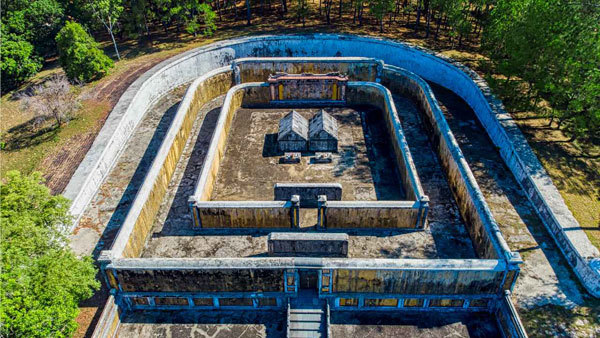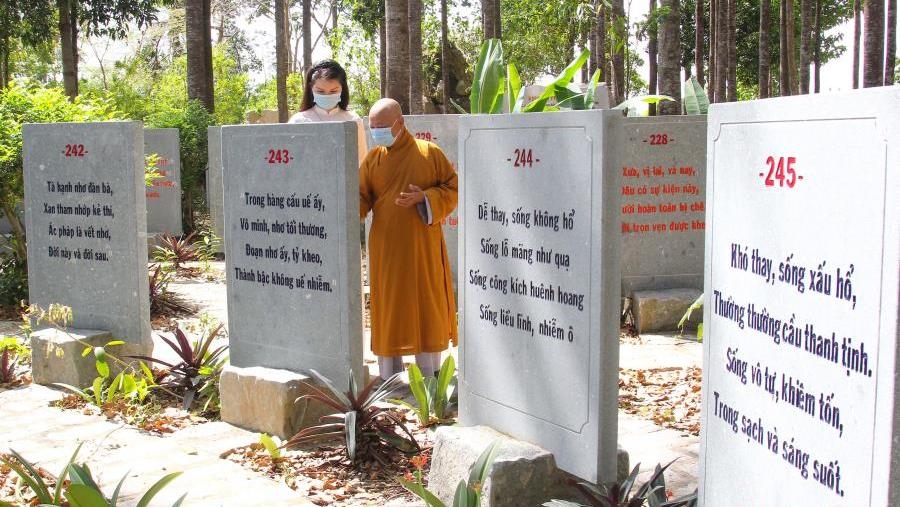The tomb of Phuc Khe General Nguyen Van Nghi (also known as the Quan Nghi mausoleum), which dates back to the 16th century, is a national historical relic.
General Nguyen Van Nghi was posthumously granted the Thai Bao Thuy Phuc Khe, after his passing at the age of 69 (1525-1595). In 1554, the Year of the Tiger, he was the top student in the Faculty of Science. Le Trang Tong earned his doctorate at the age of 29. Le Anh Tong and Le The Tong both studied under his tutelage.
The entire area of the relics covers 38,000 square meters. In addition to the outside clay citadel and inner stone citadel, the temple space has several architectural components with a variety of purposes placed within two closed walls totaling 16,000 square meters.
The wooden architectural clusters in the shape of the Chinese words "Cong," "Tam," "Nhi," and "Nhat" typical of post-Le dynasty architecture are found inside the inner citadel.
The path leading from the outer city to the inner area is lined with boulders and flanked by rows of stone dogs, stone horses, stone elephants and guardian deities.
With each word and pattern on the 2.5m wide stele meticulously etched by hand, onlookers are astounded by the attention to detail that went into each stele. Aside from that, there is a well with intricate designs from a bygone age.
The words, translated as “General of the Gate”, are etched above the dome-shaped entry gate. More than 1.5m wide, this massive stone wall was created with rows of boulders separated by a clay filler and topped with turtle shell-shaped stones that face downward. The total inner city wall length is in seven kilometers. A lot of damage was done when a section of the wall was turned into a bridge.
Over time, vegetation has somewhat obscured the top of the gate's dragon stone seal, whose head turns towards the temple.
 |
|
The gate to the temple of General Nguyen Van Nghi is made of stone. |
 |
|
Temple dedicated to General Nguyen Van Nghi |
 |
|
Stone walls surround the tomb and the temple. |
 |
|
Outside the entrance gate are many stone animals. |
 |
 |
 |
|
Ancient stone wells. |
 |
|
The Dragon Stone Seal is placed on the gate facing the temple. |
 |
 |
 |
|
Elephants, horses, and dogs are on either side of the gate. |
 |
|
A giant stone stele with a roof inscribed with the merits of General Nguyen Van Nghi. |
Le Duong

King Gia Long’s Mausoleum: the tomb of the first emperor of the Nguyen Dynasty
The mausoleum of King Gia Long is the tomb complex of the first king and founder of the Nguyen Dynasty (1802-1945).

Unique Buddhist scripture garden in Vinh Long Province
Visitors to Phuoc Hau Temple in Vinh Long Province will marvel at a garden of stone steles inscribed with the Buddha’s teachings from the Dhammapada.

Stone lion statues - Symbol of stone sculpture art of Ly Dynasty
A pair of stone lion statues at Ba Tam pagoda-temple complex is a symbol of the pinnacle of stone carving technique during the Ly Dynasty, showing the skillfulness and high aesthetic sense of artisans.